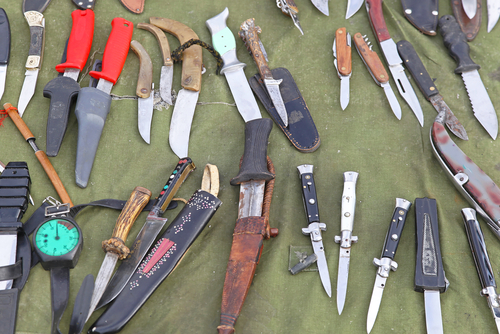Knife 101: Types of Knives and Blades
Oct 8th 2019
With so many knife options available, it can be a bit overwhelming for a new comer to the market. At EKnives, we're always here to help you select the perfect knife and happy to answer any of your questions. When it comes to selecting a knife, it comes down to how you want to use it, your budget, and your unique preferences. Let's take a look at the different types of knives and blades available:

Types of Knives
There are many types of knives on the market today, here is a look at some that styles we feature in our store:
- Fighting / Combat Knife - A knife with an aggressive blade design used to inflict pain to another individual in a confrontational environment. (eg. Bowie Knife)
- Dagger - A combat fighting weapon with a full length double edge used for stabbing or thrusting. The spine and edges are sharpened the full length of the knife.
- Throwing Knife - A weapon that has a perfect weight and balance used for throwing at objects.
- Tactical / Military Knife - A knife used in extreme situations by the Military and is often referred to as a "fighting knife" or "Military knife".
- Hunting Knife - A knife used for hunting and cutting, skinning and preparing wild animals (game)
- Pocket Knife - a folding, locking single or multi-blade knife used to carry in the pocket of your clothing. Sizes vary and styles can include a multi-tool or Swiss Army knife which contain a blade as well as other accessories such as scissors, screwdriver and pliers.
- Survival Knife - A sturdy usually fixed blade knife with a sometimes hollow handle that contains survival essentials. eg. Rambo Knives
- Machete - A large heavy duty knife that resembles a small thick sword. Machete's are used to swing at and cut vegetation growth such as weeds thicker grass. It is also used as a deadly weapon and has been featured on the Big screen as a killing tool in many movies.
- Switchblade - Often referred to as an automatic knife which is banned in many states and countries because of it's deadly intent. The blade is housed inside the handle flips or slides out automatically and quickly with the push of a button or switch.
- Assisted Opening Knife - Often confused with the switchblade, the Spring assist knife is manually operated and contains an internal mechanism that opens the knife quickly when the blade is manually opened a quarter of the way.
- Butterfly Knife - A double edged blade with two handles that counter rotate around the tang to hide the blade in between the handles when closed.
- Utility Knife - A short blade knife with a triangular blade used for cutting fiberboard, carpet and manmade materials.
Types of Blades
Knife blades are often manufactured from a variety of steels and metals. While there are pros and cons to each option, here are some things to consider:
- Carbon Steel - is a relatively maintenance free blade comprised of carbon and iron. Is vulnerable to rust and staining.
- Stainless Steel - is very popular alloy comprised of chromium, iron, nickel and molybdenum with minute amounts of carbon.
- High Carbon Stainless Steel - A stainless steel with higher amounts of carbon which do not stain or discolor while keeping a sharp edge.
- Laminate - Create a layered sandwich effect using a tougher outer layer to resist corrosion. Still leaves the edge of a blade susceptible to corrosion.
- Titanium - A more flexible alternative to steel with a stronger strength to weight ratio and more resistant to the elements. Unable to get as sharp an edge compared to steel.
- Ceramic - A lightweight option with no maintenance and sharp edges. However is brittle and has glass like properties which allow it to break easily when dropped.
- Plastic - Not very sharp and almost always are serrated blades.
Types of Handles
The handle of a knife can be made from a variety of sources and is often textured or grooved for a better grip. Some of the most commonly used materials for a knife handle include:
- Wood - has been used forever on knives but always ended up with issued from water damage and cracking. Newer handles use a laminated wood that is much longer lasting and water/weather resistant. Exotic woods are often used in custom knives.
- Rubber - Kraton (synthetic rubber replacement made by Kraton Polymers) is more often used because of its soft nature and durability in place of rubber.
- Leather - Often used to wrap the handle of some fixed blade (military and hunting) knives for such brands as Ka-Bar.
- Injection Molding - Made from higher grade plastics and often reinforced with fiberglass or kevlar.
- Stainless Steel - A very durable yet sanitary handle often comprised of aluminum and very appealing to the eye. Steel is however slippery especially when wet but to tackle this issue knifemakers often groove or hole the handle for a better grip.
- Micarta - Is an extremely popular option that is composed of canvas, paper, linen, carbon fiber, fiber glass and other thermosetting plastics for "use knives" due to its durability and stability. It is a great insulator, water resistant and is also tacky when wet for gripping.
Whether you're looking to purchase a knife for yourself or as a gift, we have tons of in stock options for you to explore. Questions? Give us a call at (423) 525-9477 and we'll be glad to assist you.

